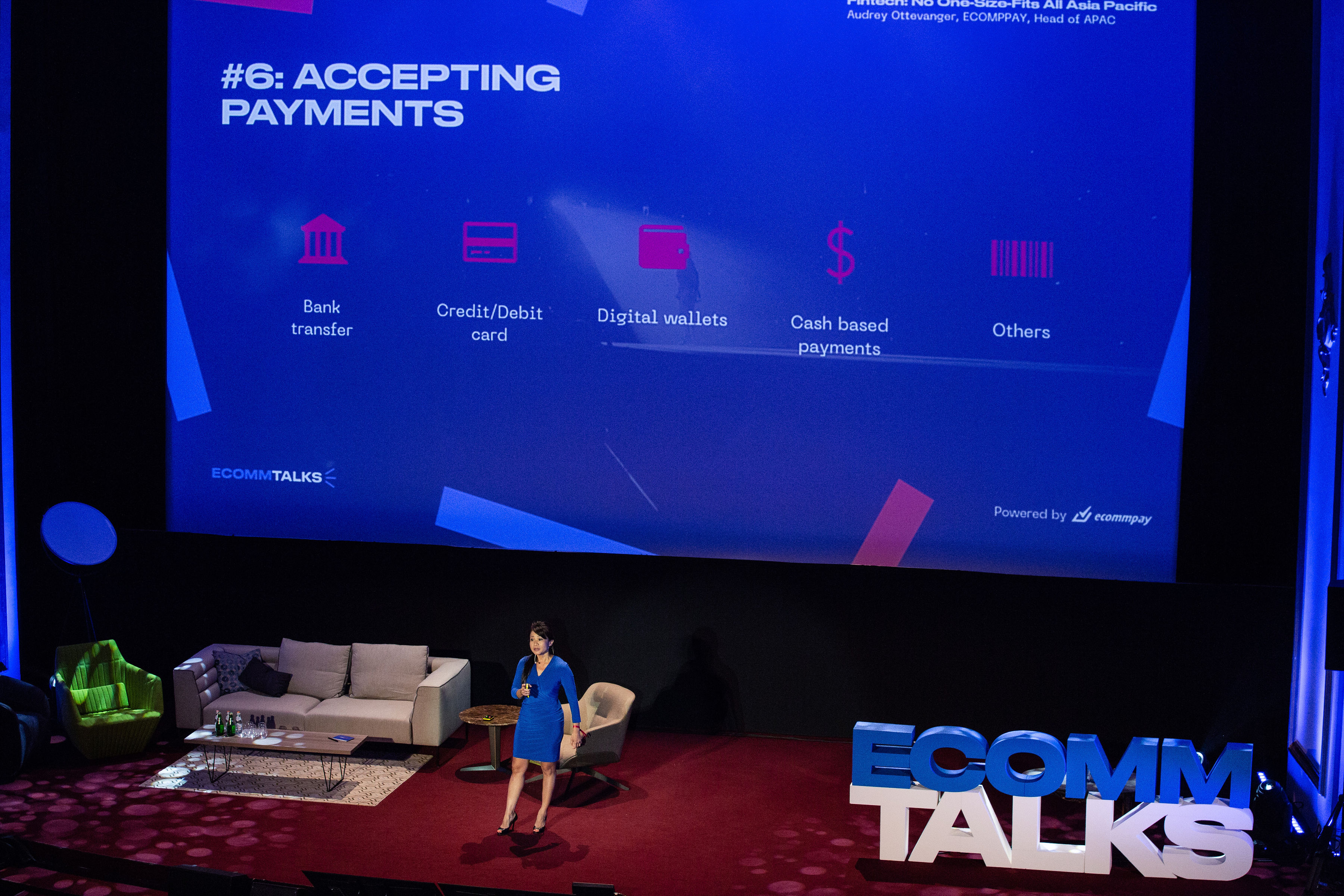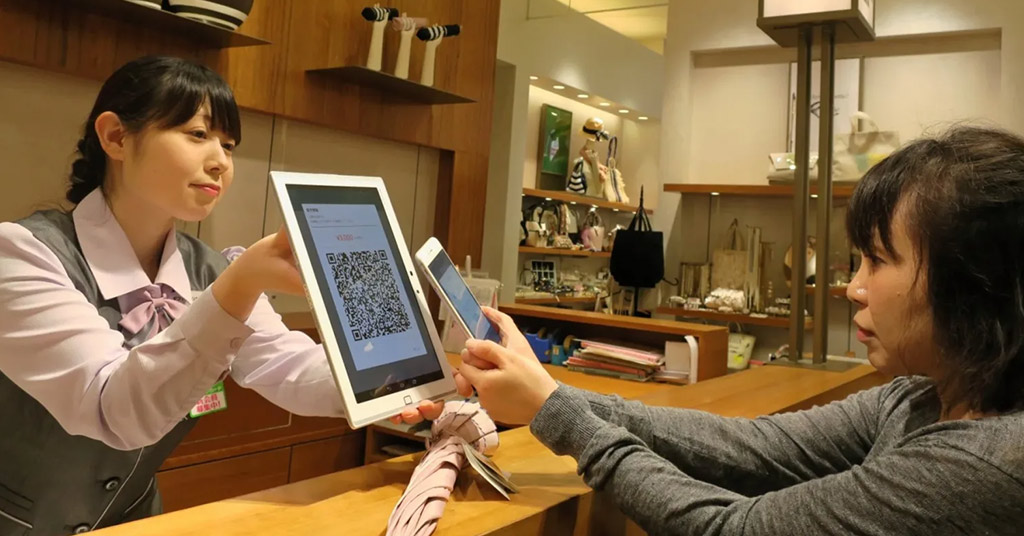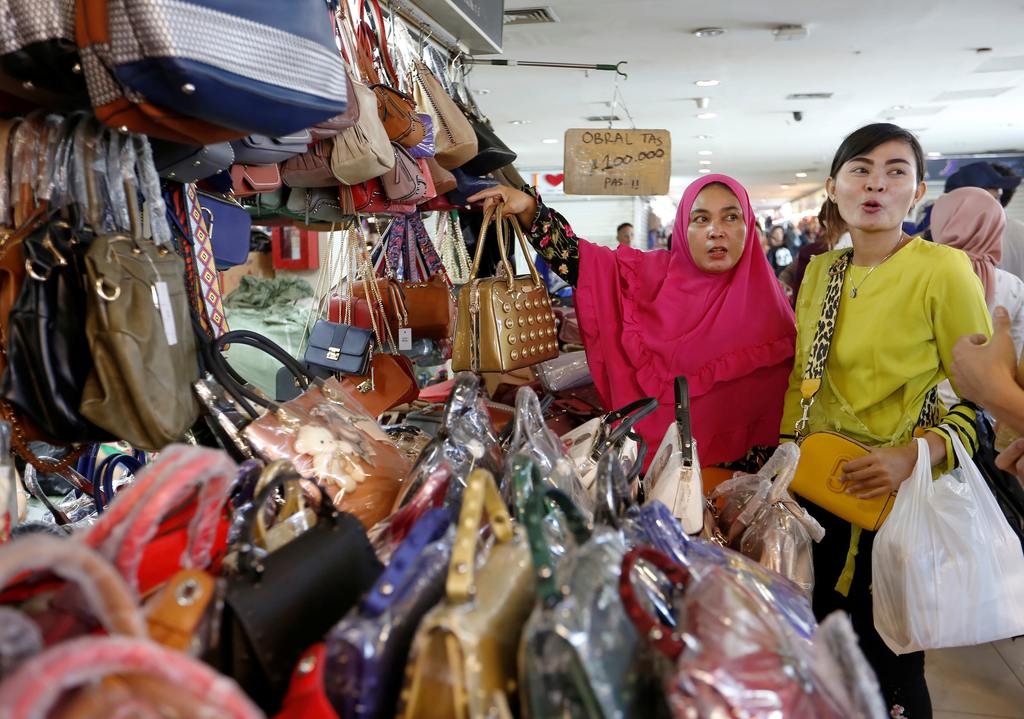Carding Forum
Professional
Advice from ECOMMPAY Asia Pacific Director Audrey Ottevanger on business entry into the Asian market

What you need to know before starting a business in Asia: top expert tips.
How to open a business in Southeast Asia (Southeast Asia), what difficulties and opportunities await entrepreneurs after entering the Asian market, and how the consumer behavior of residents of China, Singapore, Indonesia, etc. differs. from other countries - Audrey Ottevanger, Director of the international payment provider and direct acquirer ECOMMPAY for the Asia-Pacific region, spoke about this and much more during the ECOMMTALKS conference in Riga. PaySpace Magazine has collected the key points of the expert's speech.

Why business benefits from the Asian market.
Asia is one of the fastest growing and developing regions in the world with 49 countries with a total population of 4.5 billion people. At the same time, half of the world's e-commerce transactions are in China (for example, on Singles Day, the total amount of transactions amounted to $ 39.6 billion).
Asia leads in the number of millionaires, while the region also has a growing middle class. Over the next five years, 88% of the new middle class will be from the Asia-Pacific region (in particular, from Indonesia and Vietnam), whose average age will not exceed 30 years.
High level of use of mobile phones. Asia has moved from desktop computers directly to mobile phones. So, in China, 8 out of 10 transactions are made using mobile phones, therefore, to attract Asian buyers, it is necessary to provide either a mobile application or adapt the site for mobile devices.
Active investment in the region. As the expert noted, recently the volume of investments in the Asia-Pacific region amounted to $ 35 billion.
The rapid growth of e-commerce due to the development of online commerce, online tourism, online media.
Solving the problems of ecosystem services. In particular, due to startups, numerous logistical problems of the region were solved.
Active use of digital financial services (including online and offline payments). This was achieved thanks to numerous startups that provided access to financial services to residents of the region without a bank account. Nevertheless, the expert noted that despite the high level of use of digital financial services, Southeast Asia is still actively using cash to pay for goods and services.

ECOMMPAY Asia Pacific Director Audrey Ottevanger speaking.
TOP 4 segments for increasing online consumers
The most promising areas of e-commerce in Southeast Asia

Apple official store in China.
Determine the priority market size. Entrepreneurs wishing to start a business in Asia should remember that the better the market is, the higher the level of competition in it. Ottevanger also advised not to introduce your product or service in all countries of the region at once, but to identify 1-3 key markets for yourself, grouping them according to a common criterion, for example, linguistic.
Note. As an example of successful expansion, the expert mentioned a company that opened a business in the Philippines, Thailand and Indonesia - countries with the most promising markets due to the actively growing middle class.
Cultural features. It is necessary to adapt the business strategy taking into account the cultural characteristics of the countries of Southeast Asia.
In particular, the expert noted the importance of building good relations through personal communication: first, it is necessary to establish contact with local business representatives and only after that start solving business issues.
Ottevanger also emphasized the importance of linguistic and cultural adaptation for most markets in Southeast Asia, while promoting business in English is possible in Singapore, Malaysia, the Philippines and Hong Kong.

The Japanese are a monolingual nation that actively supports their national producers.
Regulation. It is necessary to study the peculiarities of taxation and capital repatriation in the countries of the region.
Note. As an example of countries with strict financial regulation, the expert named Malaysia and Indonesia, where it is prohibited by law to make foreign transfers in the national currency (Malaysian ringgit and Indonesian rupee) and trade it abroad. In Vietnam, all transactions are subject to 10% income tax.
Ottevanger noted Singapore as the best start for the expansion of Southeast Asia due to a developed market, the use of English as one of the official state languages and a large number of foreigners living in the country, thanks to which 55% of all operations in the e-commerce sector are international transactions.

The girl makes a payment for the goods using FaceID.
Omnichannel. In Asia, consumers often take an integrative shopping approach, using a smartphone to select items and a laptop to pay. In this case, the consumer can then pick up the purchases personally in the offline store.
How Asian consumers shop:

The Japanese love everything cute (kawaii), so merchants are actively using it to increase sales.

Example of payment using a QR code in Japan.
Bank transfers. This payment method is more often used in Malaysia, Thailand, Vietnam, Thailand, Indonesia and the Philippines - when paying for goods, the site redirects the user to the bank's page or generates a 16-digit code, which must then be entered to pay for the goods through an ATM or at a bank branch.
Credit / Debit Cards. Card payments are most commonly used in Singapore, Malaysia and Hong Kong. In other Southeast Asian countries, the use of credit cards is about 10%. They also use local cards that are valid only on the territory of a particular state, since their acquirer is local banks.
E-wallets. The most popular digital wallets for paying for goods and services are Alipay, UnionPay, WeChat Pay, GoPay and GrabPay wallets. Also, in some countries, local e-wallets are used for local transactions, for example, the Boost digital wallet in Malaysia.
Cash payment. This payment method is most popular in Indonesia, the Philippines and Thailand. The consumer can pay for goods and services in cash through the bank's cash desk using the payment code or QR code, or by paying for goods at the cash desk in 7-Eleven or supermarkets.
Other. Payment upon delivery of goods.
Note. Before expanding a business in each specific Asian country, it is necessary to study the most popular payment methods for the target audience and present them to buyers. For example, young people in Indonesia prefer to use e-wallets to pay, while the older generation prefers to pay in cash. At the same time, a cash payment method implies the ability to pay for a product or service in local currency.
In addition to using the mobile app and / or the mobile version of the site, it is important to make payment as easy as possible for local consumers. Filling out numerous forms during checkout can lead to customer abandonment of the purchase. Therefore, the best solution for Asian shoppers would be to add a one-click purchase option.

Consumers in Indonesia.

What you need to know before starting a business in Asia: top expert tips.
How to open a business in Southeast Asia (Southeast Asia), what difficulties and opportunities await entrepreneurs after entering the Asian market, and how the consumer behavior of residents of China, Singapore, Indonesia, etc. differs. from other countries - Audrey Ottevanger, Director of the international payment provider and direct acquirer ECOMMPAY for the Asia-Pacific region, spoke about this and much more during the ECOMMTALKS conference in Riga. PaySpace Magazine has collected the key points of the expert's speech.
Why business benefits from the Asian market

Why business benefits from the Asian market.
Asia is one of the fastest growing and developing regions in the world with 49 countries with a total population of 4.5 billion people. At the same time, half of the world's e-commerce transactions are in China (for example, on Singles Day, the total amount of transactions amounted to $ 39.6 billion).
Asia leads in the number of millionaires, while the region also has a growing middle class. Over the next five years, 88% of the new middle class will be from the Asia-Pacific region (in particular, from Indonesia and Vietnam), whose average age will not exceed 30 years.
High level of use of mobile phones. Asia has moved from desktop computers directly to mobile phones. So, in China, 8 out of 10 transactions are made using mobile phones, therefore, to attract Asian buyers, it is necessary to provide either a mobile application or adapt the site for mobile devices.
Active investment in the region. As the expert noted, recently the volume of investments in the Asia-Pacific region amounted to $ 35 billion.
The rapid growth of e-commerce due to the development of online commerce, online tourism, online media.
Solving the problems of ecosystem services. In particular, due to startups, numerous logistical problems of the region were solved.
Active use of digital financial services (including online and offline payments). This was achieved thanks to numerous startups that provided access to financial services to residents of the region without a bank account. Nevertheless, the expert noted that despite the high level of use of digital financial services, Southeast Asia is still actively using cash to pay for goods and services.

ECOMMPAY Asia Pacific Director Audrey Ottevanger speaking.
TOP 4 segments for increasing online consumers
- Online tourism
- E-commerce
- Online Games
- Ryde hailing - online travel booking
The most promising areas of e-commerce in Southeast Asia
- Tourism
- Consumer electronics
- clothing
- Household goods
- Groceries
- Health and beauty
- Other
What should a business do before entering Southeast Asia

Apple official store in China.
Determine the priority market size. Entrepreneurs wishing to start a business in Asia should remember that the better the market is, the higher the level of competition in it. Ottevanger also advised not to introduce your product or service in all countries of the region at once, but to identify 1-3 key markets for yourself, grouping them according to a common criterion, for example, linguistic.
Note. As an example of successful expansion, the expert mentioned a company that opened a business in the Philippines, Thailand and Indonesia - countries with the most promising markets due to the actively growing middle class.
Cultural features. It is necessary to adapt the business strategy taking into account the cultural characteristics of the countries of Southeast Asia.
In particular, the expert noted the importance of building good relations through personal communication: first, it is necessary to establish contact with local business representatives and only after that start solving business issues.
Ottevanger also emphasized the importance of linguistic and cultural adaptation for most markets in Southeast Asia, while promoting business in English is possible in Singapore, Malaysia, the Philippines and Hong Kong.

The Japanese are a monolingual nation that actively supports their national producers.
Regulation. It is necessary to study the peculiarities of taxation and capital repatriation in the countries of the region.
Note. As an example of countries with strict financial regulation, the expert named Malaysia and Indonesia, where it is prohibited by law to make foreign transfers in the national currency (Malaysian ringgit and Indonesian rupee) and trade it abroad. In Vietnam, all transactions are subject to 10% income tax.
Ottevanger noted Singapore as the best start for the expansion of Southeast Asia due to a developed market, the use of English as one of the official state languages and a large number of foreigners living in the country, thanks to which 55% of all operations in the e-commerce sector are international transactions.
Features of consumer behavior in Southeast Asia

The girl makes a payment for the goods using FaceID.
Omnichannel. In Asia, consumers often take an integrative shopping approach, using a smartphone to select items and a laptop to pay. In this case, the consumer can then pick up the purchases personally in the offline store.
How Asian consumers shop:
- compare prices
- study reviews of goods and services
- looking for promotions, discounts and other special offers
Features of consumer behavior in Asia

The Japanese love everything cute (kawaii), so merchants are actively using it to increase sales.
| Country | Key features |
| China | WeChat and Weibo are the most popular services Fuerdai (China's golden youth) is the best customer: they have a high income, they are not used to saving and are ready to shop all over the world Prefer to make purchases in one click Love a "loaded" user interface and prefer the color red Customer feedback is extremely important |
| Indonesia | They are active in social networks, but the percentage of online purchases is low. Most popular services: YouTube, Facebook and WhatsApp Jakarta is the city with the most active internet users Indonesia is rapidly urbanizing Website and support must be in Indonesian Indonesians love local halal products and brands |
| Singapore | Local consumers have high incomes, but they try to save money. Avid internet shoppers with a preference for foreign brands No localization needed Facebook and Instagram are the most popular social networks It is necessary to provide a convenient user experience on different devices |
| Thailand | Shopping most often occurs on social media - Facebook, Instagram and Line They prefer to use smartphones to access the Internet Customer service is extremely important. Support must be available via chats and phone calls Buy luxury goods willingly Need Thai localization |
| Philippines | Loyal to the English language Mobile native - prefer to use mobile phones Personalization is more important than privacy Product price is a key factor to purchase Social networks are actively used for shopping Product demo - essential (in particular the use of video) |
| Vietnam | Mobile native - prefer to use mobile phones The use of Vietnamese is a must Strict government control of content Facebook and Zalo are the most popular services Trends: #Urban_explosion_of_digital, #Self_fulfillment_confidence Largest eSports market in Asia |
| Malaysia | They prefer to use both laptops and mobiles. They started using smartphones for online shopping more often English is widely spoken, but outside the capital - Indonesian and Chinese Loyal to international brands Have problems with trust, but are loyal to illegal sites and goods Omnichannel Social media influencers are an important buying factor Gamification is essential to ensure interoperability |
| Japan | Monolingualism Patriotic towards domestic brands They love sites with a "loaded" design The older generation prefers laptops, young people prefer mobile phones Social networks are used with caution - it is necessary to ensure the anonymity of users Love everything kawaii (cute) |
Preferred payment methods

Example of payment using a QR code in Japan.
Bank transfers. This payment method is more often used in Malaysia, Thailand, Vietnam, Thailand, Indonesia and the Philippines - when paying for goods, the site redirects the user to the bank's page or generates a 16-digit code, which must then be entered to pay for the goods through an ATM or at a bank branch.
Credit / Debit Cards. Card payments are most commonly used in Singapore, Malaysia and Hong Kong. In other Southeast Asian countries, the use of credit cards is about 10%. They also use local cards that are valid only on the territory of a particular state, since their acquirer is local banks.
E-wallets. The most popular digital wallets for paying for goods and services are Alipay, UnionPay, WeChat Pay, GoPay and GrabPay wallets. Also, in some countries, local e-wallets are used for local transactions, for example, the Boost digital wallet in Malaysia.
Cash payment. This payment method is most popular in Indonesia, the Philippines and Thailand. The consumer can pay for goods and services in cash through the bank's cash desk using the payment code or QR code, or by paying for goods at the cash desk in 7-Eleven or supermarkets.
Other. Payment upon delivery of goods.
Note. Before expanding a business in each specific Asian country, it is necessary to study the most popular payment methods for the target audience and present them to buyers. For example, young people in Indonesia prefer to use e-wallets to pay, while the older generation prefers to pay in cash. At the same time, a cash payment method implies the ability to pay for a product or service in local currency.
In addition to using the mobile app and / or the mobile version of the site, it is important to make payment as easy as possible for local consumers. Filling out numerous forms during checkout can lead to customer abandonment of the purchase. Therefore, the best solution for Asian shoppers would be to add a one-click purchase option.
Payment methods in different countries of Southeast Asia

Consumers in Indonesia.
| Country | Payment methods | Other features |
| China | E-wallets (AliPay, WeChat Pay, Union Pay) - 54% Bank cards - 21% Bank transfers - 11% Cash - 10% Other - 4% | A website adapted for mobile devices is the most important condition for an e-commerce business For cross-border payments, registration of a legal entity or an account with a local bank is not required |
| Indonesia | Bank cards - 34% Bank transfers - 26% E-wallets - 20% Cash - 14% Other - 6% | Indonesia is a highly regulated market, the Indonesian rupiah (IDR) cannot be repatriated Payment via bank transfers prevails over cards Active use of mobile phones Increased demand for e-wallets |
| Singapore | Bank cards - 59% Bank transfers - 10% E-wallets - 14% Cash - 14% Other - 3% | Singapore dollar (SGD) - freely convertible around the world US dollar can be used for online payments High usage of credit cards 3DS-enabled transactions |
| Thailand | Bank cards - 30% Bank transfers - 23% E-wallets - 23% Cash - 15% Other - 9% | Online bank transfers and cash are the main payment methods Due to the high level of payment fraud, it is imperative for the merchant to ensure reliable protection of customer credentials It is necessary to add the ability to pay in the national currency of the country - Thai Baht (THB) |
| Philippines | Cash, e-wallets, payment through the cashier - 65% Bank transfers - 30% Bank cards - 5% | Cash is the preferred method of payment Registering a business in the Philippines is significantly cheaper than in other countries in the region The average check is less than the rest of Southeast Asia |
| Vietnam | Bank transfers - 34% Bank cards - 22% E-wallets - 19% Cash - 19% Other - 6% | Payment with debit cards issued by local banks prevails over payments with credit cards Increased demand for e-wallets Cash is still a popular payment method, but the demand for it will decrease Income tax on all transactions - 10% |
| Malaysia | Bank transfers - 46% Bank cards - 29% Other - 11% E-wallets - 7% Cash - 7% | Internet banking - most popular with local consumers FPX payment service is not available for cross-border payments for legal entities without local registration Strict financial regulation, the Malaysian ringgit is a non-tradable currency that cannot be used for international transfers 3DS - required |
| Japan | Bank cards - 65% Bank transfers - 14% Cash - 13% Other - 6% E-wallets - 2% | Cards (in particular, of the JCB payment system) are the main method of payment Cash payment in local mini-supermarkets (Konbini) is most popular among teenagers Low level of fraud Localization is extremely important |
